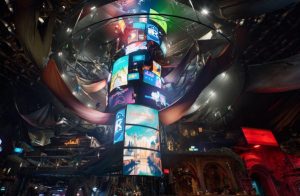Ray tracing has redefined lighting realism in modern gaming, offering cinematic-quality reflections, shadows, and global illumination that were once unattainable. As triple-A titles embrace this technology, the visual fidelity of games continues to surpass previous generations. However, higher realism comes at a cost, often leading to performance trade-offs that demand high-end GPUs to maintain stable frame rates.
To tackle these limitations, Unreal Engine 5.5 introduces MegaLights, a groundbreaking innovation revealed at Unreal Fest in Seattle. MegaLights revolutionizes lighting systems by allowing thousands of dynamic shadow-casting lights in a scene without overwhelming system resources. This advancement has the potential to reshape game design, ensuring visually stunning worlds that run efficiently on modern hardware.
What is MegaLights Unreal Engine 5.5’s Next-Gen Lighting?
Expanding Creative Possibilities in Game Design
Unveiled by Wyeth Johnson, Senior Director for Product Strategy at Epic Games, MegaLights enables developers to break free from lighting limitations. Traditional lighting techniques in games often rely on pre-baked shadows or limited dynamic lights to balance performance. MegaLights, however, scales dynamically, allowing thousands of light sources to cast shadows in real time, enriching atmospheric depth and immersion.
During the live demo, a vibrant marketplace scene featured over 1,000 dynamic light sources, illustrating the “Mega” aspect of this technology. The ability to fill an environment with intricate lighting details without sacrificing performance is a significant breakthrough for artists and designers aiming to craft rich, visually compelling game worlds.
The Power of Shadows: How MegaLights Enhances Realism
Bringing Depth and Atmosphere to Game Environments
While hundreds of light sources in a scene are impressive, MegaLights’ true strength lies in its ability to generate realistic, dynamic shadows. Initially, the demo’s marketplace appeared visually engaging, but it wasn’t until the shadows were fully activated that the scene truly came to life.
By leveraging movable and highly detailed shadow casting, MegaLights can simulate real-world lighting behavior, whether from street lamps, flickering neon signs, or fast-moving objects like drones. This dynamic interplay between light and shadow enhances immersion, creating a world where lighting no longer feels static or artificial but rather part of the evolving game environment.
Performance Efficiency: Running MegaLights on a PlayStation 5
High-Quality Lighting Without Overloading System Resources
One of the most remarkable aspects of MegaLights is its optimized performance, particularly on console hardware. Developers have long struggled with balancing visual fidelity and frame rates, often reducing lighting quality to maintain smooth performance.
To showcase its efficiency, Epic Games ran the MegaLights demo on a standard PlayStation 5, proving that high-quality, dynamic lighting doesn’t require high-end PC hardware. This advancement ensures that next-gen lighting technology can be implemented in both high-budget and mid-range game development, making cinematic visuals more accessible across different gaming platforms.

Industry Reactions: What Developers Are Saying About MegaLights
Game Artists and Industry Experts Weigh In
Prominent developers have already expressed enthusiasm for MegaLights’ potential. Del Walker, a senior character artist known for Star Wars Jedi: Survivor, took to social media to highlight how lighting compromises often degrade visual quality on consoles. His statement, “This can next-gen your next-gen games,” underscores how MegaLights eliminates previous graphical trade-offs, allowing developers to push visual boundaries without sacrificing performance.
This feedback indicates that MegaLights is not just a minor improvement but a major step forward in lighting technology, capable of reshaping how modern games achieve realism and artistic expression.
Beyond Graphics: How MegaLights Enhances Gameplay and Storytelling
Lighting as a Narrative and Gameplay Element
Lighting is not just a visual upgrade—it plays a critical role in storytelling and player immersion. With MegaLights, developers can create more nuanced, emotionally-driven scenes where lighting is a key factor in shaping mood, tension, and interaction.
For instance:
✔ Dynamic streetlights guiding players in open-world environments.
✔ Realistic horror game lighting that reacts to player movement.
✔ Shifting time-of-day systems that affect exploration and gameplay.
By removing the traditional constraints of static lighting, MegaLights expands creative possibilities, allowing for richer, more interactive gaming experiences.
What MegaLights Means for the Future of Gaming
Paving the Way for Next-Gen Game Design
As gaming technology evolves, the integration of advanced lighting solutions like MegaLights will be crucial for shaping the next wave of game design. The ability to render thousands of real-time light sources efficiently will not only elevate visuals but also provide game developers with unprecedented creative freedom.
The success of MegaLights will likely inspire broader adoption of dynamic lighting in gaming engines, leading to:
✔ More cinematic storytelling with real-time lighting adjustments.
✔ Open-world games with day-night cycles that feel more natural.
✔ Immersive RPGs with torch-lit dungeons and dynamic atmospheric effects.
As the first wave of MegaLights-powered titles begins to emerge, players and developers alike will be watching closely to see how this innovation shapes the industry.
Final Thoughts: Why MegaLights is a Game-Changer
✔ MegaLights eliminates previous limitations on shadow-casting lights, enabling richer environments.
✔ It runs efficiently even on PlayStation 5 hardware, proving it’s accessible beyond high-end PCs.
✔ Game developers praise its ability to enhance realism without performance sacrifices.
✔ It expands possibilities for storytelling, immersion, and gameplay design.
As Unreal Engine 5.5’s most ambitious lighting feature, MegaLights represents a paradigm shift in how games utilize lighting for artistic and technical advancement. With new creative opportunities on the horizon, this breakthrough technology ensures that future games will not just look better—but feel more immersive than ever before.
What are your thoughts on MegaLights? Are you excited for next-gen lighting in Unreal Engine 5.5? Let us know in the comments!


Leave a Reply